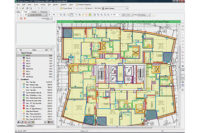Part one of this series covered action items for avoiding project overruns during the pre-construction phase. Topics covered included: the need for a thorough review of the quantity takeoff and budget done for bidding purposes; incorporating value engineering to save money on materials, labor, and equipment; project managers completing their own independent takeoff and pricing; and best practices for establishing a construction budget.
A high percentage of a project’s budget is labor, for example in Division 9 labor is approximately 60 percent of a project’s budget. It is imperative that a company fully understand and manage labor production. Analyzing and understanding historical labor and production information assists in creating guidelines for accurate bidding on future jobs but also for active job site management. If this historical data is not available then consider conducting onsite time trials. These trials involve assigning specific tasks to workers in the field and recording how much work is completed in a given time period. The trials should be conducted under real field conditions, if possible, using typical work performed on a regular basis such as wall framing, drywall hanging or installing ceiling grid.
EFFICIENT UTILIZATION
Good construction project management must vigorously pursue the efficient utilization of labor, material, and equipment. Improvement of labor productivity should be a major and continual concern of those who are responsible for cost control of constructed facilities. Material handling, which includes procurement, inventory, shop fabrication and field delivery, also requires special attention for cost reduction.
Poorly managed and mismanaged material stocking has a devastating effect on a project’s success and profitability. Materials delivered in the wrong quantities, at the wrong location at the wrong time negatively affect an entire jobsite and delays or stops work for several trades at one time. A well-planned and “field friendly” material management and stocking plan changes the overall project entirely. Material might only represent one-third of the total job cost, yet labor spent looking for materials is in the range of 13 to 15 percent of total labor costs. Studies of heavy construction sites reflect that the introduction of materials management results in 6 to 8 percent cost savings.
The goal is to have material available when it is needed—not before and not after. A stocking list should be broken down into manageable pieces. If a portion of the work is on hold, or awaiting a change order then break those out and ship everything except that scope of work. It takes a few minutes to breakdown a stocking list and saves hundreds of labor hours on a project if properly done. Use of color-coded site coordination drawings can also be leveraged to give more precise information as to the exact locations and date of delivery of the required materials.
MANAGING AND MONITORING LABOR COSTS
A common complaint among foreman and project managers is that they do not have the information to effectively monitor and manage their labor costs. In most cases, the data is available. Job cost management requires six components: estimated quantities, estimated hours, method to measure installed quantities and corresponding hours, percentage complete to calculate earned value, actual payroll data, and a report to calculate job-to-date and project costs. When this information is readily available, the foreman and the project manager must review this data. When done in a timely manner such as each week, they know if the project is making money and what the projected profit margin are at the end of the job. Additionally, they have the ability to look at the number and dive in if it looks wrong. It is possible to turn around a “losing” job if it is done early in construction (approximately 25 percent complete). The longer a problem goes unnoticed the less time there is to react and the lower the likelihood that it can be positively affected.
The construction documents (agreement, drawings, and specifications) developed by the architects and engineers specify the conditions agreed upon between the owner and the contractor. These documents reflect the understanding that each party has with regards to constructing the project they represent. If every set of construction documents were clear, unambiguous, and complete, interpretation wouldn’t be necessary—the intent and understanding of the parties would be self-evident. Unfortunately, this is not always the case.
In most construction documents, it is inevitable that the agreement, drawings, and specifications will not adequately address every single matter. There may be gaps, conflicts or gray areas that require clarification. Requests for Information provide opportunities to clarify issues and avoid conflicts. Project managers should write RFIs as early in the process as possible so that the foreman is not impacted during construction. Before a question is asked the project manager should determine if there is a cost impact. Whether there is or isn’t a cost impact there is likely to be a schedule impact. When crafting the question, it must be written in a way that creates a billable document. Also, the RFI should include pictures of: the plan showing the conflict, the elevation, details of the situation, work that’s completed (including date and time stamps). A solution should be proposed, making note that the conflict may result in a cost or schedule impact of a specified amount. In closing, the RFI must include a ‘need answer by’ date and log the time between submitting the question and receiving the reply.
REQUESTED CHANGES
One of the greatest threats to profitability on any job is requested changes. Changes get communicated in plan modifications, RFIs, meetings, conversations, phone calls, job walks, and change of scope. Whether changes are noted clearly clouded on drawings, delivered in letters or placed in Additional Work Authorization documents: Document, document, document! When the project is under construction it is the responsibility of the project manager and the foreman to manage the job. It is critical to prepare and modify labor and material budgets to fit how the job will actually be built and managed on site. The project manager should visit the jobsite at regular intervals, keep daily logs on the project, and include job photos and videos.
A takeoff and bid used to sell work is not the same as a takeoff and budget used to build a job. Estimators, project managers, and foremen should collaborate to generate the most accurately detailed and documented project possible. They should deploy Value Engineering to save on materials, labor, and equipment. They should be actively engaged in the project construction. This participation brings a fresh pair of eyes to the site and provides helpful information that may have been missed during daily job duties. Overruns are avoided when project management is an ongoing process from bid to completion. Not all companies deploy these best practices. Be the exception and be more profitable. W&C











